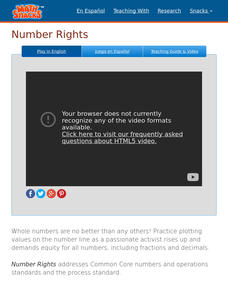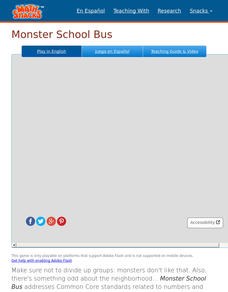Winnipeg School Division Numeracy Project
Dot Card and Ten Frame Activities
What fun, simple number value activities these are! Using dot cards and ten frames, 34 educational games are briefly described to help diversify these great strategies. For example, in the game "I Wish I Had..." the teacher holds up a...
K20 LEARN
Airplanes and Airstrips, Part 2
Table the decision to land. Pupils form flight crews by matching up different representations of linear equations. Given a set of coordinates for an airstrip, the crews determine the equation of the line that will position their planes...
Flipped Math
Calculus AB/BC - Determining Concavity of Functions over Their Domains
Time to take a second look at derivatives finding concavity. While watching the video, learners find out the definition of concavity. Individuals see how to determine whether an interval is concave up or concave down using graphs and the...
College Board
Civic Knowledge and Action: Voter Registration
What does the data say? Using provided voter data from the 2016 presidential election, scholars describe the data and identify questions they could answer by analyzing it. Learners then construct tables and use them to determine whether...
Flipped Math
Calculus AB/BC - Derivatives of tan(x), cot(x), sec(x), and csc(x)
Continue to differentiate the rest of the trigonometric functions. Pupils see the derivatives of the other four trigonometric functions and begin to memorize the rules. Learners see examples that show that the calculus portion of a...
Flipped Math
Calculus AB/BC - The Quotient Rule
Some differentiation rules are just better to memorize. The ninth lesson in a unit of 11 presents the quotient rule to pupils for them to memorize. Learners use the quotient rule to determine the derivative of two quotients after seeing...
Flipped Math
Calculus AB/BC - The Product Rule
There's more to derivatives of multiplication than simply the product of the derivatives. A helpful video gives learners the product rule of finding the derivative of the product of two functions. Pupils find the derivatives of functions...
Flipped Math
Calculus AB/BC - Derivatives of cos(x), sin(x), e^x, and ln(x)
The shortcuts are not just for polynomial functions. Pupils learn the derivatives of the two basic trigonometric functions, cosine and sine. The video provides the derivatives for exponential and logarithmic functions. Learners work...
Flipped Math
Calculus AB/BC - Derivative Rules: Constant, Sum, Difference, and Constant Multiple
Use derivatives to find equations of lines. Pupils learn more rules to use as shortcuts to find derivatives. Using the rules, they find the equations of the tangent line and the normal line at a given point. Scholars then apply the new...
Flipped Math
Calculus AB/BC - The Power Rule
There has to be a quicker way. Pupils learn the power rule that allows for a shortcut to take the derivative of terms to a power. Using the newly found rule, scholars find the slope of the tangent line to a function at a given x value....
Flipped Math
Calculus AB/BC - Connecting Differentiability and Continuity
Despite what you thought, you can differentiate between continuity and differentiability. Using a short lesson, pupils learn how differentiability and continuity relate to each other. It provides three descriptions of when a function is...
Flipped Math
Calculus AB/BC - Estimating Derivatives of a Function at a Point
It seems like it should be about three. Pupils learn to get an estimate of the derivative of a function at a point by using the derivative functionality of their graphing calculators. They take that information to determine the equation...
Flipped Math
Calculus AB/BC - Defining the Derivative of a Function and Using Derivative Notation
Pupils learn how to find the derivative of a function by applying the definition using limits. Learners understand that the derivative provides the slope of the tangent line and use that information to find the equation of the tangent...
Flipped Math
Calculus AB/BC - Average and Instantaneous Rate of Change
Ramp up the average rate of change—instantly. Learners use their knowledge of the formula to find the average rate of change to find the instantaneous rate of change. The presenter shows pupils an interactive that demonstrates finding...
EngageNY
Solutions to Polynomial Equations
Take a step back to Algebra II. The first activity in a series of 23 asks scholars to remember working with quadratic equations with complex solutions. Pupils apply polynomial identities to complex numbers and work examples that show how...
New Mexico State University
Number Rights
You do not have to be whole to be important. Individuals watch a video on the importance of rational numbers on the number line. Scholars use their knowledge to rename numbers on the number line as well as place rationals on a number...
New Mexico State University
Pearl Diver
Dive into the number line. Learners play a computer game that revolves around a number line as they try to collect pearls by diving at locations on a number line. As the game progresses, dive locations change from simple whole numbers to...
New Mexico State University
Monster School Bus
Load up the bus. Pupils play a game where they control a bus to pick up a certain number of monsters for school. Learners develop strategies to make sure they have a full load and score the most rewards. As scholars work through the...
New Mexico State University
Game Over Gopher
Coordinate an attack on hungry gophers. Scholars play a game that relies on placing objects on the coordinate plane to stop gophers from eating a carrot. As the game levels increase, learners encounter different scales and the need to...
New Mexico State University
Atlantean Dodgeball
Develop ratios within sporting games. Class members watch a video about dodgeball and see how coaches compare the scores. Pupils then work with ratios to compare the scores throughout the tournament. Using their knowledge of ratios, they...
New Mexico State University
Bad Date
Get the best ratio for a good date. The class watches a video where dates are rated based on the ratio of words spoken. Pupils then use the ratios in the video along with other given ratios to find equivalent ratios. Finally, they...
Collaborative for Academic, Social, and Emotional Learning (CASEL)
Examples of Social and Emotional Learning in Elementary Mathematics Instruction
A 12-page document lists an abundance of math-related activities that boost social and emotional topics; self-awareness, self-management, social awareness, relationship skills, and responsible decision making.
Radford University
Rocket Quads
How high will it fly? Pairs build straw rockets and launch them at different angles and determine the height and horizontal distance of the flight path. Teams make conjectures about how the angle affects the measured distances and use...
Radford University
Projectile Motion and Quadratic Functions
Model the flight of a ball. Small groups collect time data for how long it takes to toss a ball between two people. The teacher leads a discussion about projectile motion to get the class thinking about how to calculate the equation of...

























